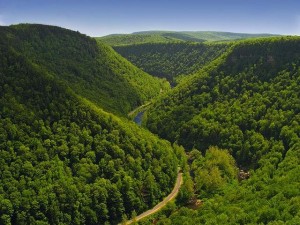
UNIVERSITY PARK – Despite continuing development, urban sprawl and changing land use, Pennsylvania’s forest area has remained stable in recent decades, according to a forest scientist in Penn State’s College of Agricultural Sciences.
The most recent USDA Forest Service forest inventory report offers data from 2009, the latest available. The report indicates that the amount of forest cover hovers at about 59 percent of total land area, or about 16.7 million acres.
Some parts of the state are gaining forest cover while others are losing it, explained James Finley, Ibberson Professor of Forest Resources Management. This trend has been occurring since the mid-1960s as the forest recovered from heavy cutting in the late 1800s and early 1900s.
“Land-use patterns suggest that the amount of forested acreage has remained stable because losses caused by development in the Southern Tier have been offset by gains resulting from agriculture declines in the Northern Tier counties,” he said. “As reported by the Forest Service, trees and forests still dominate Pennsylvania’s landscape. Most of this forestland — about 71 percent — is held privately by individuals, families, partnerships and other entities not in the business of harvesting and using trees.”
A recent Penn State study estimated there are 738,000 private ownerships in the state. Most of these ownerships are small parcels; often, they come with the home. In fact, about 420,000 of these ownerships are smaller than 10 acres, and about 25 percent of the private forest is in ownerships of less than 20 acres.
“Statewide there are only about 25,000 privately owned forest tracts larger than 100 acres in size,” Finley said. “This study and others suggest that the average size of our privately owned forest tracts is decreasing.”
The Forest Service estimates the Keystone State has 3.4 percent fewer trees than it did when a similar report was done in 2004. However, while the number of trees has dropped slightly, the estimated volume of trees increased, Finley noted. Between 2004 and 2009, the average volume per acre of Pennsylvania forest increased by 60 cubic feet, from 2,138 to 2,198 cubic feet.
“If you consider this from a cordwood perspective, that means that the average acre of woodlands in the state now holds about 27 cords of wood and increased in volume by just under a cord in the five years between inventories,” he said.
Pennsylvania still is growing more wood than it uses, Finley pointed out. As a major part of the state’s rural economy, the forest industry harvests trees for many uses. Recent data shows that the “growth-to-remove” ratio is 2:1 for timberland — meaning that the forest is growing twice as much as is harvested.
But Pennsylvania’s forest outlook is not entirely rosy, Finley cautioned. Sixty-seven percent of the forestland lost during the inventory period — which was offset primarily by agricultural abandonment — was converted to essentially nonreversible uses.
“The report also conveys concerns about potential impacts from non-native insects and diseases that increasingly are affecting forests,” he said. “Among these are gypsy moth, hemlock wooly adelgid, emerald ash borer, Asian long-horned beetle, thousand cankers disease, sudden oak death and the list goes on.
“Added to this are the rapid invasion and expansion of non-native, exotic plants that are filling our old fields and woodlands with aggressive competitors. That list, too, is long and growing.”
Finley said he is concerned about the continuing failure of Pennsylvania forests to establish adequate tree regeneration in woodlands disturbed by harvesting and other events. Using guidelines developed by the USDA Forest Research Lab near Warren, the 2009 inventory assessed adequacy of tree regeneration.
When there was canopy disturbance sufficient to initiate and sustain seedling growth and development, only four of 10 acres had sufficient desirable regeneration to replace the overstory.
“Desirable species are those important to product manufacturing and wildlife. These include oaks, maples, ashes and hickory,” he said. “If the list of species was expanded to all commercially desirable species, such as birch, beech, blackgum, elm, black locust and aspen, only half the forest is in good shape.”
Forest regeneration issues are not new to the state, Finley said. Repeatedly, research has pointed to regeneration concerns caused by white-tailed deer, competing plants — such as ferns, grass, beech and striped maple — acid deposition and a host of exotic species.
The Pennsylvania’s Forests 2009 report is available online.


